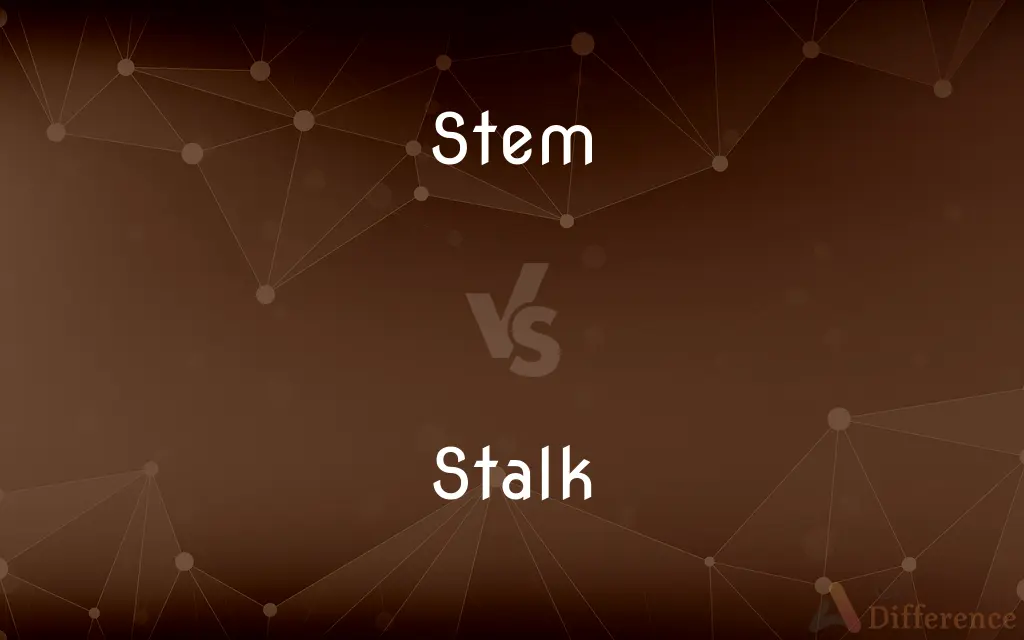Stem vs. Stalk — What's the Difference?
By Urooj Arif & Maham Liaqat — Updated on March 21, 2024
A stem is the main central part of a plant, providing structural support and transport for nutrients, while a stalk refers specifically to the supporting structure of leaves, flowers, or fruits.

Difference Between Stem and Stalk
Table of Contents
ADVERTISEMENT
Key Differences
The stem is a crucial component of a plant's anatomy, serving as the main axis that provides support, facilitates water and nutrient transport, and houses the vascular system. It plays a pivotal role in photosynthesis by elevating the plant’s leaves towards the light and can also store nutrients. Whereas, the stalk is a term often used interchangeably with stem but typically refers to the slender, elongated support structures of leaves, flowers, or fruits. Stalks are part of the plant's stem system but are specialized to support specific plant parts.
Stems are characterized by their girth and strength, which enable them to support the plant body. They grow upwards, branching out to form a framework that supports leaves, flowers, and fruits. On the other hand, stalks, such as petioles, pedicels, and flower stalks, are generally narrower and more flexible, designed to support individual plant elements rather than the entire plant.
In botanical terms, the stem is defined as the plant organ bearing nodes and internodes, from which leaves and buds emerge. It is integral to the plant’s growth, as it can produce new living tissue from meristematic cells located at the tips. In contrast, a stalk may refer to any slender supporting structure, including petioles (leaf stalks), peduncles (flower stalks), and stolons (runners), each with a specific role in supporting and positioning plant parts for optimal growth and reproduction.
While all plants have stems, not all have distinguishable stalks. Stems provide the main architectural support for the plant and have the capacity for considerable growth and branching. Stalks, however, are often more specialized and may not be present in plants where leaves or flowers grow directly from the stem.
The terminology can vary based on the plant part being described. For instance, the term "stalk" is more commonly used in reference to the structures that support flowers (peduncles) or leaves (petioles), highlighting their role in positioning these parts for optimal function. Conversely, the stem is a more encompassing term that describes the central part of the plant, responsible for overall support and transport.
ADVERTISEMENT
Comparison Chart
Definition
Main central part of a plant
Supports leaves, flowers, or fruits
Function
Support, nutrient transport, photosynthesis
Supports and positions specific plant parts
Structure
Thick, strong, capable of growth
Slender, elongated, flexible
Presence
Found in all plants
Not present in all plants
Botanical Role
Bearing nodes and internodes
Specialized support (e.g., petioles, peduncles)
Compare with Definitions
Stem
Can store nutrients and water, aiding plant survival.
Cactus stems store water to survive desert conditions.
Stalk
Elevates plant parts for better access to light and pollinators.
The stalks lifted the flowers above the leaves to attract bees.
Stem
The main central part of a plant, supporting branches, leaves, and flowers.
The rose stem was sturdy, holding up numerous blooms.
Stalk
Supports individual elements, not the entire plant.
The pea plants clung to the garden trellis with their stalks.
Stem
Carries water, nutrients, and sugars between roots and leaves.
The plant's stem was critical in transporting nutrients from the soil.
Stalk
Specifically refers to structures like petioles and peduncles.
The sunflower's stalk bent under the weight of its bloom.
Stem
Houses the vascular system of the plant.
The stem's vascular system efficiently transported water to the leaves.
Stalk
A slender support for leaves, flowers, or fruits.
Each leaf on the plant was attached by a thin stalk.
Stem
Grows upwards, branching to support leaves and flowers.
The tree's stem branched out, forming a canopy.
Stalk
Can be a runner, spreading horizontally to propagate the plant.
Strawberry plants spread through thin stalks called runners.
Stem
The main ascending part of a plant; a stalk or trunk.
Stalk
A stem or main axis of a herbaceous plant.
Stem
A slender stalk supporting or connecting another plant part, such as a leaf or flower.
Stalk
A stem or similar structure that supports a plant part such as a flower, flower cluster, or leaf.
Stem
A banana stalk bearing several bunches of bananas.
Stalk
A slender or elongated support or structure, as one that holds up an organ or another body part.
Stem
The tube of a tobacco pipe.
Stalk
To pursue or track (prey) stealthily
The lions stalked the zebra from the tall grass.
Stem
The slender upright support of a wineglass or goblet.
Stalk
To follow or observe (a person) persistently, especially out of obsession or derangement.
Stem
The small projecting shaft with an expanded crown by which a watch is wound.
Stalk
To go through (an area) in pursuit of prey or quarry.
Stem
The rounded rod in the center of certain locks about which the key fits and is turned.
Stalk
To walk with a stiff, haughty, or angry gait
Stalked off in a huff.
Stem
The shaft of a feather or hair.
Stalk
To move threateningly or menacingly.
Stem
The upright stroke of a typeface or letter.
Stalk
To track prey or quarry.
Stem
(Music) The vertical line extending from the head of a note.
Stalk
The stem or main axis of a plant, which supports the seed-carrying parts.
A stalk of wheat, rye, or oats;
The stalks of maize or hemp
Stem
The main line of descent of a family.
Stalk
The petiole, pedicel, or peduncle of a plant.
Stem
(Linguistics) The main part of a word to which affixes are added.
Stalk
Something resembling the stalk of a plant, such as the stem of a quill.
Stem
(Nautical) The curved upright beam at the fore of a vessel into which the hull timbers are scarfed to form the prow.
Stalk
(architectural element) An ornament in the Corinthian capital resembling the stalk of a plant, from which the volutes and helices spring.
Stem
The tubular glass structure mounting the filament or electrodes in an incandescent bulb or vacuum tube.
Stalk
One of the two upright pieces of a ladder.
Stem
To have or take origin or descent
Her success stems mostly from hard work.
Stalk
(zoology)
Stem
To remove the stem of
Stemmed the apples.
Stalk
A stem or peduncle, as in certain barnacles and crinoids.
Stem
To provide with a stem
Wine glasses that are stemmed.
Stalk
The narrow basal portion of the abdomen of a hymenopterous insect.
Stem
To make headway against (a tide or current, for example).
Stalk
The peduncle of the eyes of decapod crustaceans.
Stem
To stop or stanch (a flow)
Stemmed the bleeding.
Stalk
(metalworking) An iron bar with projections inserted in a core to strengthen it; a core arbor.
Stem
To restrain or stop
Wanted to stem the growth of government.
Stalk
A particular episode of trying to follow or contact someone.
Stem
To plug or tamp (a blast hole, for example).
Stalk
The hunting of a wild animal by stealthy approach.
Stem
(Sports) To turn (a ski, usually the uphill ski) by moving the heel outward.
Stalk
A haughty style of walking.
Stem
To stem a ski or both skis, as in making a turn.
Stalk
(transitive) To approach slowly and quietly in order not to be discovered when getting closer.
Stem
The stock of a family; a race or generation of progenitors.
Stalk
(transitive) To (try to) follow or contact someone constantly, often resulting in harassment.Wp
My ex-girlfriend is stalking me.
Stem
A branch of a family.
Stalk
(intransitive) To walk slowly and cautiously; to walk in a stealthy, noiseless manner.
Stem
An advanced or leading position; the lookout.
Stalk
(intransitive) To walk behind something, such as a screen, for the purpose of approaching game; to proceed under cover.
Stem
(botany) The above-ground stalk (technically axis) of a vascular plant, and certain anatomically similar, below-ground organs such as rhizomes, bulbs, tubers, and corms.
Stalk
(intransitive) To walk haughtily.
Stem
A slender supporting member of an individual part of a plant such as a flower or a leaf; also, by analogy, the shaft of a feather.
The stem of an apple or a cherry
Stalk
The stem or main axis of a plant; as, a stalk of wheat, rye, or oats; the stalks of maize or hemp.
Stem
A narrow part on certain man-made objects, such as a wine glass, a tobacco pipe, a spoon.
Stalk
That which resembles the stalk of a plant, as the stem of a quill.
Stem
(linguistics) The main part of an uninflected word to which affixes may be added to form inflections of the word. A stem often has a more fundamental root. Systematic conjugations and declensions derive from their stems.
Stalk
An ornament in the Corinthian capital resembling the stalk of a plant, from which the volutes and helices spring.
Stem
(slang) A person's leg.
Stalk
One of the two upright pieces of a ladder.
To climb by the rungs and the stalks.
Stem
(typography) A vertical stroke of a letter.
Stalk
A stem or peduncle, as of certain barnacles and crinoids.
Stem
(music) A vertical stroke marking the length of a note in written music.
Stalk
An iron bar with projections inserted in a core to strengthen it; a core arbor.
Stem
(music) A premixed portion of a track for use in audio mastering and remixing.
Stalk
A high, proud, stately step or walk.
Thus twice before, . . . With martial stalk hath he gone by our watch.
The which with monstrous stalk behind him stepped.
Stem
(nautical) The vertical or nearly vertical forward extension of the keel, to which the forward ends of the planks or strakes are attached.
Stalk
The act or process of stalking.
When the stalk was over (the antelope took alarm and ran off before I was within rifle shot) I came back.
Stem
(cycling) A component on a bicycle that connects the handlebars to the bicycle fork.
Stalk
To walk slowly and cautiously; to walk in a stealthy, noiseless manner; - sometimes used with a reflexive pronoun.
Into the chamber he stalked him full still.
[Bertran] stalks close behind her, like a witch's fiend,Pressing to be employed.
Stem
(anatomy) A part of an anatomic structure considered without its possible branches or ramifications.
Stalk
To walk behind something as a screen, for the purpose of approaching game; to proceed under cover.
The king . . . crept under the shoulder of his led horse; . . . "I must stalk," said he.
One underneath his horse, to get a shoot doth stalk.
Stem
(slang) A crack pipe; or the long, hollow portion of a similar pipe (i.e. meth pipe) resembling a crack pipe.
Stalk
To walk with high and proud steps; - usually implying the affectation of dignity, and indicating dislike. The word is used, however, especially by the poets, to express dignity of step.
With manly mien he stalked along the ground.
Then stalking through the deep,He fords the ocean.
I forbear myself from entering the lists in which he has long stalked alone and unchallenged.
Stem
A winder on a clock, watch, or similar mechanism.
Stalk
To follow (a person) persistently, with or without attempts to evade detection; as, the paparazzi stalk celebrities to get candid photographs; obsessed fans may stalk their favorite movie stars.
Stem
Alternative form of STEM
Stalk
Material consisting of seed coverings and small pieces of stem or leaves that have been separated from the seeds
Stem
A lesbian, chiefly African-American, exhibiting both stud and femme traits.
Stalk
A slender or elongated structure that supports a plant or fungus or a plant part or plant organ
Stem
To remove the stem from.
To stem cherries; to stem tobacco leaves
Stalk
A hunt for game carried on by stalking or waiting in ambush
Stem
To be caused or derived; to originate.
The current crisis stems from the short-sighted politics of the previous government.
Stalk
The act of following prey stealthily
Stem
To descend in a family line.
Stalk
A stiff or threatening gait
Stem
To direct the stem (of a ship) against; to make headway against.
Stalk
Walk stiffly
Stem
(obsolete) To hit with the stem of a ship; to ram.
Stalk
Follow stealthily or recur constantly and spontaneously to;
Her ex-boyfriend stalked her
The ghost of her mother haunted her
Stem
To ram (clay, etc.) into a blasting hole.
Stalk
Go through (an area) in search of prey;
Stalk the woods for deer
Stem
(skiing) To move the feet apart and point the tips of the skis inward in order to slow down the speed or to facilitate a turn.
Stem
To gleam.
His head bald, that shone as any glass, . . . [And] stemed as a furnace of a leed [caldron].
Stem
To remove the stem or stems from; as, to stem cherries; to remove the stem and its appendages (ribs and veins) from; as, to stem tobacco leaves.
Stem
To ram, as clay, into a blasting hole.
Stem
To move forward against an obstacle, as a vessel against a current.
Stemming nightly toward the pole.
Stem
A gleam of light; flame.
Stem
The principal body of a tree, shrub, or plant, of any kind; the main stock; the part which supports the branches or the head or top.
After they are shot up thirty feet in length, they spread a very large top, having no bough nor twig in the trunk or the stem.
The lowering spring, with lavish rain,Beats down the slender stem and breaded grain.
Stem
A little branch which connects a fruit, flower, or leaf with a main branch; a peduncle, pedicel, or petiole; as, the stem of an apple or a cherry.
Stem
The stock of a family; a race or generation of progenitors.
While I do pray, learn here thy stemAnd true descent.
Stem
A branch of a family.
This is a stemOf that victorious stock.
Stem
A curved piece of timber to which the two sides of a ship are united at the fore end. The lower end of it is scarfed to the keel, and the bowsprit rests upon its upper end. Hence, the forward part of a vessel; the bow.
Stem
Fig.: An advanced or leading position; the lookout.
Wolsey sat at the stem more than twenty years.
Stem
Anything resembling a stem or stalk; as, the stem of a tobacco pipe; the stem of a watch case, or that part to which the ring, by which it is suspended, is attached.
Stem
That part of a plant which bears leaves, or rudiments of leaves, whether rising above ground or wholly subterranean.
Stem
The entire central axis of a feather.
Stem
The short perpendicular line added to the body of a note; the tail of a crotchet, quaver, semiquaver, etc.
Stem
The part of an inflected word which remains unchanged (except by euphonic variations) throughout a given inflection; theme; base.
Stem
(linguistics) the form of a word after all affixes are removed;
Thematic vowels are part of the stem
Stem
A slender or elongated structure that supports a plant or fungus or a plant part or plant organ
Stem
Cylinder forming a long narrow part of something
Stem
The tube of a tobacco pipe
Stem
Front part of a vessel or aircraft;
He pointed the bow of the boat toward the finish line
Stem
A turn made in skiing; the back of one ski is forced outward and the other ski is brought parallel to it
Stem
Grow out of, have roots in, originate in;
The increase in the national debt stems from the last war
Stem
Cause to point inward;
Stem your skis
Stem
Remove the stem from;
For automatic natural language processing, the words must be stemmed
Common Curiosities
What is the primary function of a stem?
The stem provides structural support, facilitates nutrient and water transport, and can store resources.
Can a stem also be called a stalk?
In common usage, "stalk" can refer to parts of the stem, especially when discussing support for specific plant parts.
How does a stalk support plant reproduction?
By elevating flowers or fruits, it helps in attracting pollinators or aids in the dispersion of seeds.
What botanical roles do stems play?
Stems bear nodes and internodes, support leaves and flowers, transport nutrients, and can produce new living tissue.
What makes a stalk different in terms of structure?
Stalks are typically more slender and flexible, designed to support specific parts rather than the entire plant.
How does a stalk differ from a stem?
A stalk specifically supports leaves, flowers, or fruits, whereas a stem is the main support for the entire plant.
What are examples of plant parts considered as stalks?
Petioles (leaf stalks), peduncles (flower stalks), and stolons (runners) are all types of stalks.
Is the function of a stalk different from that of a stem?
Yes, while stems support the whole plant and transport nutrients, stalks specifically support and position leaves, flowers, or fruits.
Do all plants have stems and stalks?
All plants have stems, but not all have distinguishable stalks, depending on their structure and growth habit.
Why is the stem considered crucial for a plant's survival?
It's essential for structural support, nutrient transport, and often for water and nutrient storage, directly impacting the plant’s growth and health.
Share Your Discovery

Previous Comparison
Hoody vs. Hoodie
Next Comparison
Primate vs. MammalAuthor Spotlight
Written by
Urooj ArifUrooj is a skilled content writer at Ask Difference, known for her exceptional ability to simplify complex topics into engaging and informative content. With a passion for research and a flair for clear, concise writing, she consistently delivers articles that resonate with our diverse audience.
Co-written by
Maham Liaqat















































